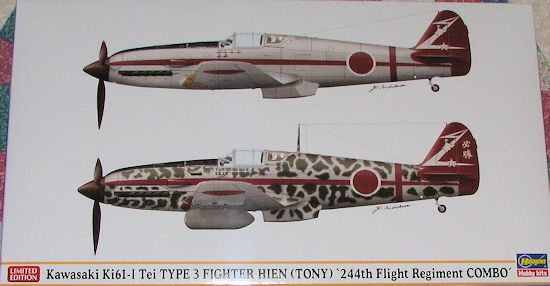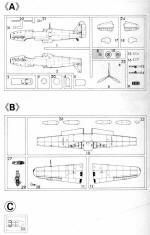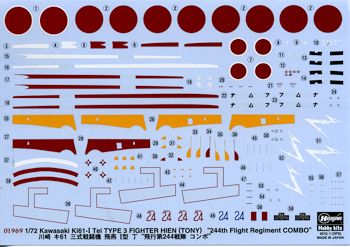
| KIT #: | 01969 |
| PRICE: | $14.99 on sale ($43.00 SRP) |
| DECALS: | Three options |
| REVIEWER: | Scott Van Aken |
| NOTES: | Two complete kits |

| HISTORY |
The Kawasaki Ki-61 Hien (飛燕, "flying swallow") was a Japanese World War II fighter aircraft used by the Imperial Japanese Army Air Force. The first encounter reports claimed Ki-61s were Messerschmitt Bf 109s: further reports claimed that the new aircraft was an Italian design, which led to the Allied reporting name of "Tony", assigned by the United States War Department. The Japanese Army designation was "Army Type 3 Fighter" (三式戦闘機). It was the only mass-produced Japanese fighter of the war to use a liquid-cooled inline V engine. Over 2,500 Ki-61s were produced, first seeing action around New Guinea in 1943, and continuing to fly combat missions throughout the war.
The 244th Sentai is one of the most famous of the Ki-61 Home Defense units. It had nine Bukosho recipients. Major Teruhiko Kobayashi JAAF's youngest Sentai commander. Also had an air-to-air B-29 ramming unit. Sentai claimed 73 B-29s shot down plus 92 damaged. Captain Nagao Shirai considered the ranking ace of 244 Sentai and possibly leading B-29 "killer" of JAAF (11 B-29s plus two F6Fs destroyed, six other aircraft damaged using Ki-61 and Ki-100. Captain Chuichi Ichikawa nine B-29s plus one F6F destroyed, six B-29s damaged. Major Teruhiko Kobayashi, three B-29s plus two F6Fs destroyed.
| THE KIT |
 This
is one of Hasegawa's early engraved panel line kits. If you have built their
P-47, then you know what to expect. The cockpit is about as basic as it gets. It
has a floor with the seat pan molded in place. The only other part is the seat
back. No control stick as you are supposed to install the rather generic pilot
figure. Fortunately, for about what I paid for this pair of kits, you can find a
resin cockpit set. The instrument panel is a flat piece onto which you place a
decal, which is pretty standard 1/72 from a number of kit makers.
This
is one of Hasegawa's early engraved panel line kits. If you have built their
P-47, then you know what to expect. The cockpit is about as basic as it gets. It
has a floor with the seat pan molded in place. The only other part is the seat
back. No control stick as you are supposed to install the rather generic pilot
figure. Fortunately, for about what I paid for this pair of kits, you can find a
resin cockpit set. The instrument panel is a flat piece onto which you place a
decal, which is pretty standard 1/72 from a number of kit makers.
The only fuselage bit to install before closing the halves, aside from the cockpit, is a blanking plate for the top of the radiator tub. The rudder is molded to one side of the fuselage. Wings are a single lower piece with two upper wing halves. The stabilizers are a single piece for each side. Wheel wells are a bit shallow. Gear are fairly nicely done with the inner gear doors needing to be cut from the lower gear door if modeling it gear down. The wheels are quite plain, but they are actually like that. Resin replacements are available, but in my opinion would be a waste of money.
Exhaust, supercharger intake, and radiator cooler inlet are separate pieces. This is all topped with a one piece canopy. For those who want the prop to spin, the prop will need to be installed when closing the fuselage halves and the spinner added later. In addition to the pilot, there is a standing figure who is saluting.
This could easily be called a Kobayashi set as all three aircraft on the sheet
are his various aircraft while with the 244th Sentai. His first plane from
February 1945 while based at Chofu is shown on the box art and is unpainted
metal with a red tail. All of the options have this feature as well as a black
anti- glare
panel and brown primer prop and spinner. The second option, also shown on the
box art, is from March 1945, also at Chofu. Note on this option that all the
mottling was applied after all the markings were placed. This aircraft has red
leading edge ID bands instead of the usual yellow. The last option is from
Dec 1944-Jan 1945 when based at Hamamatsu. This plane is also heavily mottled
and in fact has many solid sections. In this case, it looks like the markings
were placed on the aircraft after the upper surface was painted. All have decals
for the leading edge ID bands though the tails will have to be painted.
Undersurfaces are all unpainted metal. The decal sheet is very nicely printed
with data markings for two planes.
glare
panel and brown primer prop and spinner. The second option, also shown on the
box art, is from March 1945, also at Chofu. Note on this option that all the
mottling was applied after all the markings were placed. This aircraft has red
leading edge ID bands instead of the usual yellow. The last option is from
Dec 1944-Jan 1945 when based at Hamamatsu. This plane is also heavily mottled
and in fact has many solid sections. In this case, it looks like the markings
were placed on the aircraft after the upper surface was painted. All have decals
for the leading edge ID bands though the tails will have to be painted.
Undersurfaces are all unpainted metal. The decal sheet is very nicely printed
with data markings for two planes.
| CONCLUSIONS |
Typical of current Hasegawa kits, the SRP is far too expensive, but getting the kit on sale like this makes it much more acceptable. The kit is quite basic and though I've not built one, should go together without any real fuss.
| REFERENCES |
http://en.wikipedia.org/wiki/Ki-61
November 2013
Thanks to your editor for getting this one on sale.
If you would like your product reviewed fairly and quickly, please contact the editor or see other details in the Note to Contributors.